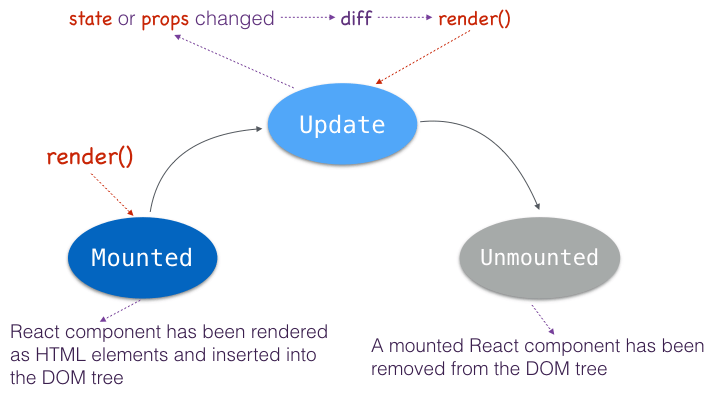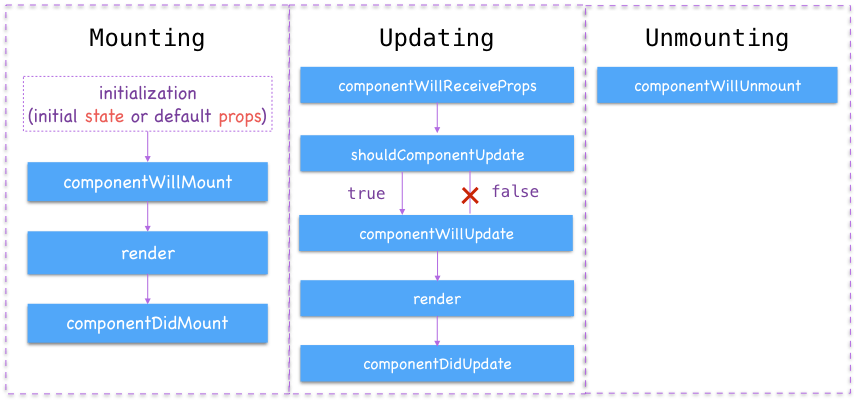React.js Tutorial: React Component Lifecycle
Introduction about React component lifecycle.
1 Lifecycle
A React component in browser can be any of the following three statuses: mounted, update and unmounted.

So React component lifecycle can be divided into three phases according to these statuses: mounting, updating and unmounting.

2 Mounting
React.js exposed interfaces or hook methods in each phase of component lifecycle.
2.1 Initializing state
You can optionally set initial state value in constructor() method of the component if you are using ES6 syntax.
const tom_and_jerry = [
{
name: 'Tom',
score: 55
},
{
name: 'Jerry',
score: 80
}
];
class ScoreBoard extends React.Component {
constructor(props) {
super(props);
this.state = { players: tom_and_jerry }
}
// ...
}If you are using ES5 syntax, getInitialState() in the right place to initialize component state.
var ScoreBoard = React.createClass({
getInitialState: function() {
return {
players: tom_and_jerry
}
},
// ...
});The getInitialState() method is called only one time before the component is mounted.
Initialization of state should typically only be done in a top level component, which acts as a role of controller view in your page.
2.2 Default props
You can also define default values of component props (properties) if the parent component does not declare their values.
Return default props using ES7+ static property initializer.
class SinglePlayer extends React.Component {
static defaultProps = {
name: 'Nobody',
score: 0
}
// ...
}Default props in ES6:
class SinglePlayer extends React.Component {
// ...
}
SinglePlayer.defaultProps = {
name: 'Nobody',
score: 0
}You can define getDefaultProps() method in ES5.
var SinglePlayer = React.createClass({
getDefaultProps: function() {
return {
name: 'Nobody',
score: 0
}
}
});The getDefaultProps() method is called only once before any instance of the component is created. So you should avoid using this.props inside getDefaultProps() method.
2.3 componentWillMount()
The componentWillMount() method is invoked only once before initial rendering.
It is also a good place to set initial state value inside componentWillMount().
class SinglePlayer extends React.Component {
componentWillMount() {
this.setState({
isPassed: this.props.score >= 60
});
alert('componentWillMount => ' + this.props.name);
console.log('componentWillMount => ' + this.props.name);
}
// ...
}2.4 componentDidMount()
This lifecycle method will be invoked after rendering.
It is the right place to access DOM of the component.
class ScoreBoard extends React.Component {
constructor(props) {
super(props);
this._handleScroll = this.handleScroll.bind(this);
}
handleScroll() {}
componentDidMount() {
alert('componentDidMount in NoticeBoard');
window.addEventListener('scroll', this._handleScroll);
}
// ...
}3 Updating
3.1 componentWillReceiveProps()
void componentWillReceiveProps(object nextProps)This method will be invoked when a component is receiving new props. componentWillReceiveProps() won't be called for the initial rendering.
class SinglePlayer extends React.Component {
componentWillReceiveProps(nextProps) {
// Calculate state according to props changes
this.setState({
isPassed: nextProps.score >= 60
});
}
}The old props can be accessed via this.props inside componentWillReceiveProps(). Typically, you can set state according to changes of props in this method.
3.2 shouldComponentUpdate()
boolean shouldComponentUpdate(object nextProps,
object nextState)shouldComponentUpdate() will be invoked before rendering when new props or state are being received. This method won't be called on initial rendering.
shouldComponentUpdate() returns true by default.
This method is usually an opportunity to prevent the unnecessary rerendering considering performance. Just let shouldComponentUpdate() return false, then the render() method of the component will be completely skipped until the next props or state change.
class SinglePlayer extends React.Component {
shouldComponentUpdate(nextProps, nextState) {
// Don't rerender if score doesn't change,
if ( nextProps.score == this.props.score ) {
return false;
}
return true;
}
}3.3 componentWillUpdate()
void componentWillUpdate(object nextProps,
object nextState)Invoked just before render(), but after shouldComponentUpdate() (of course, return a true). This method is not called for the initial rendering.
Use this as an opportunity to prepare for an update.
class SinglePlayer extends React.Component {
componentWillUpdate(nextProps, nextState) {
alert('componentWillUpdate => ' + this.props.name);
console.log('componentWillUpdate => ' + this.props.name);
}
}3.4 componentDidUpdate()
void componentDidUpdate(object prevProps,
object prevState)Invoked immediately after the component's updates are flushed to the DOM. This method is not called for the initial rendering.
You can perform DOM operations after an update inside this function.
class SinglePlayer extends React.Component {
componentDidUpdate(prevProps, prevState) {
alert('componentDidUpdate => ' + this.props.name);
console.log('componentDidUpdate => ' + this.props.name);
}
}4 Unmounting
void componentWillUnmount()This is invoked immediately before a component is unmounted or removed from the DOM.
Use this as an opportunity to perform cleanup operations. For example, unbind event listeners here to avoid memory leaking.
class ScoreBoard extends React.Component {
componentWillUnmount() {
window.removeEventListener('scroll', this._handleScroll);
}
}5 Sample codes
Complete sample codes to log each lifecycle method call in browser's console.
<!DOCTYPE html>
<html lang="en">
<head>
<meta charset="UTF-8">
<title>React Component Lifecycle Demo</title>
<!-- react includes two parts: react.js and react-dom.js -->
<script src="//fb.me/react-15.2.1.js"></script>
<script src="//fb.me/react-dom-15.2.1.js"></script>
<!-- babel standalone -->
<script src="//cdnjs.cloudflare.com/ajax/libs/babel-standalone/6.10.3/babel.min.js"></script>
</head>
<body>
<div id="app"></div>
<script type="text/babel">
const tom_and_jerry = [
{
name: 'Tom',
score: 55
},
{
name: 'Jerry',
score: 80
}
];
class SinglePlayer extends React.Component {
constructor(props) {
super(props);
this.state = { isPassed: false }
}
componentWillMount() {
// Mark it as 'Pass' if score >= 60
this.setState({
isPassed: this.props.score >= 60
});
console.log('componentWillMount => ' + this.props.name);
alert('componentWillMount => ' + this.props.name);
}
componentDidMount() {
console.log('componentDidMount => ' + this.props.name);
alert('componentDidMount => ' + this.props.name);
}
componentWillReceiveProps(nextProps) {
// Calculate state according to props changes
this.setState({
isPassed: nextProps.score >= 60
});
console.log('componentWillReceiveProps => ' + this.props.name + ': ' + nextProps.score);
alert('componentWillReceiveProps => ' + this.props.name + ': ' + nextProps.score);
}
shouldComponentUpdate(nextProps, nextState) {
// Don't rerender if score doesn't change,
if ( nextProps.score == this.props.score ) {
console.log('shouldComponentUpdate => ' + this.props.name + '? false');
alert('shouldComponentUpdate => ' + this.props.name + '? false');
return false;
}
console.log('shouldComponentUpdate => ' + this.props.name + '? true');
alert('shouldComponentUpdate => ' + this.props.name + '? true');
return true;
}
componentWillUpdate(nextProps, nextState) {
console.log('componentWillUpdate => ' + this.props.name);
alert('componentWillUpdate => ' + this.props.name);
}
componentDidUpdate(prevProps, prevState) {
console.log('componentDidUpdate => ' + this.props.name);
alert('componentDidUpdate => ' + this.props.name);
}
componentWillUnmount() {
console.log('componentDidUpdate => ' + this.props.name);
alert('componentDidUpdate => ' + this.props.name);
}
render() {
console.log("render => " + this.props.name);
return (
<div>
<h5><span>Name: </span>{this.props.name}</h5>
<p><span>Score: </span><em>{this.props.score}</em></p>
<p><span>Pass: </span><input type="checkbox" defaultChecked={this.state.isPassed} disabled={true} /></p>
</div>
);
}
}
class ScoreBoard extends React.Component {
constructor(props) {
super(props);
this.state = {
players: tom_and_jerry
};
}
changeScore(amount) {
if ( typeof(amount) != "number" ) {
return;
}
let players = this.state.players;
let tom = players[0];
tom.score = tom.score + amount;
tom.score = (tom.score > 100) ? 100 : tom.score;
tom.score = (tom.score < 0) ? 0 : tom.score;
players[0] = tom;
this.setState({ players: players });
}
render() {
return (
<div>
<h4>Score Board</h4>
<div>
<button onClick={ (amount) => this.changeScore(5) }>Score of Tom: +5</button>
<button onClick={ (amount) => this.changeScore(-5) }>Score of Tom: -5</button>
</div>
{
this.state.players.map((v, idx) => {
return <SinglePlayer key={idx} name={v.name} score={v.score} />
})
}
</div>
);
}
}
class App extends React.Component {
render() {
return (
<div>
<h1>React Component Lifecycle Demo</h1>
<ScoreBoard />
</div>
)
}
}
// Mount root App component
ReactDOM.render(<App />, document.getElementById('app'));
</script>
</body>
</html>
https://www.codevoila.com/post/57/reactjs-tutorial-react-component-lifecycleReact.js Tutorial: React Component Lifecycle的更多相关文章
- WHAT IS THE DIFFERENCE BETWEEN REACT.JS AND REACT NATIVE?
Amit Ashwini - 09 SEPTEMBER 2017 React.js was developed by Facebook to address its need for a dynami ...
- [React] 10 - Tutorial: router
Ref: REACT JS TUTORIAL #6 - React Router & Intro to Single Page Apps with React JS Ref: REACT JS ...
- React.js入门笔记
# React.js入门笔记 核心提示 这是本人学习react.js的第一篇入门笔记,估计也会是该系列涵盖内容最多的笔记,主要内容来自英文官方文档的快速上手部分和阮一峰博客教程.当然,还有我自己尝试的 ...
- Facebook React.js库 入门实例教程
作者: 阮一峰 日期: 2015年3月31日 现在最热门的前端框架,毫无疑问是 React . 上周,基于 React 的 React Native 发布,结果一天之内,就获得了 5000 颗星,受瞩 ...
- React.js入门
React 入门实例教程 现在最热门的前端框架,毫无疑问是 React . 上周,基于 React 的 React Native 发布,结果一天之内,就获得了 5000 颗星,受瞩目程度可见一斑. ...
- 13个精选的React JS框架
如果你正在使用 React.js 或 React Native 创建用户界面,可以试一试本文推荐的这些框架. React.js 和 React Native 是流行的用户界面(UI)开发平台,且都是开 ...
- React JS 基础知识17条
1. 基础实例 <!DOCTYPE html> <html> <head> <script src="../build/react.js" ...
- react.js 从零开始(一)
React 是什么? 网络上的解释很多...我这里把他定义为 通过javascript 的形式组件化 html的框架... React 仅仅是 VIEW 层. React 提供了模板语法以及一些函数钩 ...
- 【每天半小时学框架】——React.js的模板语法与组件概念
[重点提前说:组件化与虚拟DOM是React.js的核心理念!] 先抛出一个论题:在React.js中,JSX语法提倡将 HTML 和 CSS 全都写入到JavaScrip ...
随机推荐
- [转帖]k8s 部署问题解决
k8s 部署问题解决 https://www.jianshu.com/p/f53650a85131 本文记录一下在部署 k8s 时遇到的一些问题及解决方法,具体部署流程可以参考 ubuntu 安装 k ...
- DDR3(2):初始化
调取 DDR3 IP核后,是不能直接进行读写测试的,必须先进行初始化操作,对 IP 核进行校验.本篇采用 Modelsim 软件配合 DDR3 IP核生成的仿真模型,搭建出 IP核的初始化过程. 一. ...
- Tomcat 对静态资源的处理
Tomcat 中的请求都是由 Servlet 处理,静态资源也不例外.在默认的 web.xml 中,配置了一个 DefaultServlet 用于处理静态资源,它支持缓存和断点续传. DefaultS ...
- 创建一个RAS 非对称 公私密钥示例
static void Main(string[] args) { RSAParameters pub; RSAParameters priv; using (var rsa = new RSACry ...
- Kafka Internals: Consumers
Check out my last article, Kafka Internals: Topics and Partitions to learn about Kafka storage inter ...
- 将fileupload标签的值清空
在开发中遇到了这样一个问题,在一个form表单中,有一个fileupload标签,新增,修改都是同一个form,当我第一次选择了上传文件路径,并且提交之后,第二次再使用这个form,这次没有选择上传文 ...
- springboot整合docker部署
环境安装 首先,需要安装Docker(例如:docker for windows) 下载地址:https://download.docker.com/win/stable/Docker%20for%2 ...
- CodeForces 309B Context Advertising
洛谷题目页面传送门 & CodeForces题目页面传送门 给定一个\(n\)个单词的文本,第\(i\)个单词的长度为\(len_i\),要求截取文本的一段(单词必须取整的),分若干行放,同行 ...
- PAT 1020月饼
月饼是中国人在中秋佳节时吃的一种传统食品,不同地区有许多不同风味的月饼.现给定所有种类月饼的库存量.总售价.以及市场的最大需求量,请你计算可以获得的最大收益是多少. 注意:销售时允许取出一部分库存.样 ...
- js之正则
1.正则的声明方法 1)var reg = /abc/; "这个叫对象直接量方式": 2)var reg = new RegExp("abc") 这个叫构造函数 ...
